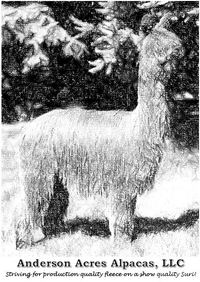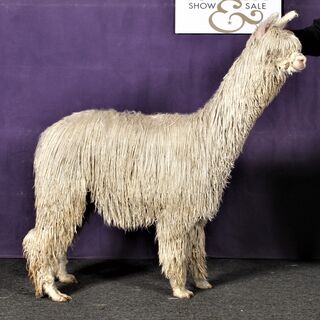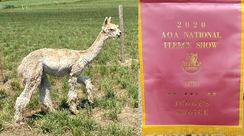0
items
You have no items in your shopping cart.
Welcome to Anderson Acres Alpacas, LLC
Superb 2023 EPDs!
The 2023 EPDs are in and we are proud of the results for our herd. Check them out by clicking on the EPDs link on the right side of the page for each individual alpaca. A few of the very best EPDs are pictured on this page.
Our breeding program is striving for production quality fleeces on show quality Suri alpacas by using information collected in many ways and from different sources. First, we have studied genetics and the quality of offspring produced by certain males and females. We want pedigrees to include alpacas that have historically produced quality offspring. By studying pedigrees, we look to purchase quality Suris as our foundation herd and when studying the conformation found in each alpaca in our herd, a person will find it to be exemplary.
Second, we have shown our alpacas and their fleeces at shows throughout the country to hear what judge's have to say. We listen seriously to those comments and work to maintain strengths and improve upon the weaknesses found in our Suris.
Third, we have collected sound scientific, mathematical data on our foundation herd from different sources and are continuing to do that. We are working on getting all of our production females fiber tested and in the database with the AOA for Expected Progeny Differences (EPDs). Look at the individual listings for our females and click on the link to check out those EPDs. You'll see a lot of them are extremely good, and some we'd say are exceptional.
We have tried to get all of our herdsires in the AOA's EPD database, too. The majority of those EPD rankings are good. One also needs to consider such things as physical size, lock structure, luster, and other things that aren't measured in EPDs when choosing the herdsire to be put with each female. Skin biopsies done to collect data on fleeces will also eventually be completed on our mature herdsires. The results for the skin biopsies show fleeces that are at the least very good and most are exceptional. Again, we look at all of this data and try to maintain strengths and improve upon weaknesses in our breeding decisions.
Second, we have shown our alpacas and their fleeces at shows throughout the country to hear what judge's have to say. We listen seriously to those comments and work to maintain strengths and improve upon the weaknesses found in our Suris.
Third, we have collected sound scientific, mathematical data on our foundation herd from different sources and are continuing to do that. We are working on getting all of our production females fiber tested and in the database with the AOA for Expected Progeny Differences (EPDs). Look at the individual listings for our females and click on the link to check out those EPDs. You'll see a lot of them are extremely good, and some we'd say are exceptional.
We have tried to get all of our herdsires in the AOA's EPD database, too. The majority of those EPD rankings are good. One also needs to consider such things as physical size, lock structure, luster, and other things that aren't measured in EPDs when choosing the herdsire to be put with each female. Skin biopsies done to collect data on fleeces will also eventually be completed on our mature herdsires. The results for the skin biopsies show fleeces that are at the least very good and most are exceptional. Again, we look at all of this data and try to maintain strengths and improve upon weaknesses in our breeding decisions.
Featured Items
White
A LUSTROUS GENETIC POWERHOUSE!
Stud Fee: $1500.00
Dark Brown
DRIPPING WITH LUSTER!
Light Brown
HANDSOME MICAH SON!
$7500.00
Light Fawn
7 BANNERS, 4 TIME JUDGE'S CHOICE!




